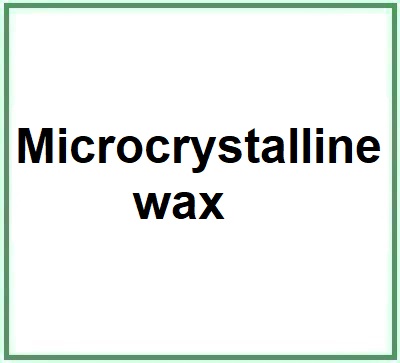Microcrystalline wax is a purified product based on saturated hydrocarbons, with a small amount of cyclic, straight-chain hydrocarbons, a residue of the oil as raw material. It is produced through a number of refining steps: propane deasphalting, propane furfural refining, oil purification of ketone benzene, white clay refining, hydrotreatment and cooling of the resulting product.
The name defines the structure of the molecule:
- Wax is a broad term that can refer to a variety of substances that are solid at room temperature but melt at higher temperatures. Waxes can be derived from a variety of sources, including plants, animals, and oil.
- Microcrystalline refers to the small size of the crystals in the wax. Microcrystalline waxes have much smaller crystals than paraffin, which is a similar product. This small size of the crystal gives the microcrystalline wax its unique properties, such as flexibility and high melting point.
Some general properties of microcrystalline wax:
- It has a fine crystal structure, from where it takes its name.
- It has a higher melting point, a higher viscosity and is denser than paraffin wax.
- It is more flexible and adhesive than paraffin wax, making it useful in a variety of applications such as cosmetics, food packaging and candle making.
The synthesis process takes place in several stages:
- Distillation of crude oil. In the first stage the process begins with crude oil, which is a complex mixture of hydrocarbons. This crude is distilled, typically in a fractionation column, to separate it into fractions based on the boiling points of the components. Heavy residues left after the distillation of useful fuels such as gasoline, kerosene and diesel are used to produce waxes.
- Deparaffination with solvent. The heavy residues are mixed with a solvent such as a mixture of methyl ethyl ketone (MEK) and toluene. This mixture is cooled, which causes the wax to precipitate out of the solution. Wax at this stage is a mixture of paraffin and microcrystalline waxes.
- Separation of wax. The wax mixture is treated to separate paraffin wax from microcrystalline wax. This is done by cooling the mixture to a temperature at which the paraffin wax solidifies but the microcrystalline wax remains liquid. Solid paraffin can then be separated from liquid microcrystalline wax by filtration or centrifugation.
- Purification. Microcrystalline wax is purified to remove any oil residues or other impurities by treating the wax with activated carbon or clay, which absorbs impurities. The purified wax is then bleached to remove any color.
- Finishing. In the final stage the properties of the wax are adjusted to meet specific needs. This may involve melting the wax with other materials, or subjecting it to further treatments such as hydrogenation to improve its color and odor.
It takes the form of a refined, odourless and tasteless wax with a white to yellowish colour. Slightly soluble in hot ethanol, soluble in benzene, chloroform, ether.

What it is used for and where
Food
Ingredient listed in the European food additives list as E905, a coating agent.
Microcrystalline wax for food use is subdivided by colour, PAH classification, oil content and melting point into five grades: 70, 75, 80, 85, 90.
Cosmetics
Used as an adhesive and emulsifying stabiliser often replacing paraffin wax as it has shown better elastic characteristics and less sticky adhesion.
Binder agent. Ingredient that is used in cosmetic, food and pharmaceutical products as an anti-caking agent with the function of making the product in which it is incorporated silky, compact and homogenous. The binder, either natural such as mucilage, gums and starches or chemical, may be in the form of a powder or liquid.
Emulsion stabilizer. Emulsions are thermodynamically unstable. Emulsion stabilisers improve the formation and stability of single and double emulsions. It should be noted that in the structure-function relationship, molar mass plays an important role.
Opacifying agent. It is useful into formulations that may be translucent or transparent to make them opaque and less permeable to light.
Viscosity control agent. It controls and adapts viscosity to the required level for optimal chemical and physical stability of the product and dosage in gels, suspensions, emulsions, solutions.
Other uses
Pharmaceutical, electrical, packaging industry, polishing, fruit (e.g. for polishing apples). as a coating agent.
Typical commercial product characteristics Microcrystalline Wax
| Appearance | Wax |
| Melting Point | 52°C-72°C |
| Oil content | ≤0,5% |
| Photolabile number | ≤4 ≤5 |
| Color Sabolt Scale | ≤+25 ≤+27 |
| Penetration | ≤17 ≤19 at 25°C 1/10mm |
| Grade | from #52 to #72 |
![]() Microcrystalline wax
Microcrystalline wax 


